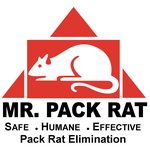|
If your life depended on having lots of safe
places to hide, where would you rather live?
How pack rats go from
natural to nuisance
Pack rats have no armor, no
venom, are not particularly fast or aggressive. Their
very survival depends on remaining hidden and building
fortress-like impenetrable nests. Food is not an issue,
but shelter is essential. The natural desert is very
open, but add people and things change. Pack rats do
not need humans to survive but will take complete
advantage of any opportunities provided.
"Keeping it
natural" is not natural at all!
When streets are put in and
homes are built things are no longer 100% natural. Just
simple runoff from roofs, patios, driveways, and streets
leads to an increase in vegetation. Most people also
want to add a little something like rosemary,
bougainvillea, lantana, and non-native cactus. To truly
keep things natural takes work. At least once a year
things need to be trimmed and thinned to create more
open space. This provides less opportunity for pack rats
and more effective hunting for predators.
Kept "natural" with thinning & trimming
Who are the real
pack rats?
People love to collect and
hold on to things and where does it all go? First,
we fill the garage, the car can sit outside. Then things
get put behind the wall, against the house, by the air
conditioner. We love our stuff and so do the pack rats
- all those great hiding places!
#1 Pack rat nest -
the cave
In nature, pack rats love crevices in caves. A
ready-built home safe from predators and weather. A pack
rat nest in a cactus may last 5-10 years until the rats
kill the cactus, but nests in caves have been
continually occupied for over 40,000 years. What do
people do? We provide ready-made caves for rats to move
into - things like vehicles, attics, pool heaters, air
conditioners, grills, and even poison bait boxes. All
enclosures are simply caves to a pack rat, providing
safe shelter from predators and weather. It is like
putting out a welcome mat.

Fewer and less
effective predators
Most predators shy away from homes. Snakes in
residential areas are often removed or even killed. Some
people think all types of rats are the same and use
poison. Pack rats are not even distant cousins to the
notorious urban Roof and Norway rats that poison baits
are designed for. Poison should never be used in areas
where there is wildlife. It is ineffective
for pack rats and often ends up killing the very
predators that keep the pack rat population in
check. Pack rats reproduce quickly, owls and bobcats do
not. Don't let a pest control or hardware store employee
tell you otherwise — secondary poisoning is a real
problem. Check out these recent articles:
The predators that do
remain are less effective hunters when the rats have
more cover under the unnaturally dense, excessive, and
overgrown vegetation typical around homes.
Conclusion
Nature loves balance. Available habitat and the
predator/prey ratio are key factors that naturally
keep the pack rat population in check. When people are
introduced the balance is upset. An increase in the
available habitat and a decrease in predators lead to a
surge in the number of pack rats. The end result
— a native wild animal; key to
a healthy Sonoran desert; becomes a nuisance.
|
